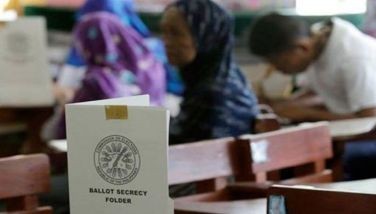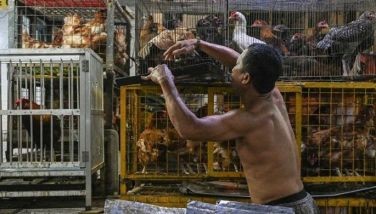Six more Sayyaf jail mutineers identified
March 18, 2005 | 12:00am
Six more detained Abu Sayyaf bandits were identified by witnesses as among those who took part in the foiled jailbreak Monday at the Metro Manila District Jail (MMDJ) detention compound at Camp Bagong Diwa in Bicutan, Taguig City.
Three witnesses have identified six more bandits as those who disarmed and killed three of the guards and wounded two others in their initial bid to escape from detention.
Police said the six Abu Sayyaf bandits survived the assault but will now face criminal charges for the deaths of the three MMDJ guards.
Chief Superintendent Ricardo Dapat, officer in charge of the Criminal Investigation and Detection Group, identified the six suspects as Munib Asa, Abu Sacay Omar, Said Masshud, Das Ismael, Radzmar Jul and Alzen Dan Jul.
The wounded guards, aided by responding Special Action Force (SAF) personnel, managed to fight back, frustrating the escape of the bandits and forcing them to retreat to the four-story Security Intensive Care Unit building in the MMDJ compound.
The botched escape turned into a hostage crisis when the bandits, armed with handguns and M-16 rifles snatched from the guards, tried to negotiate their way out of the jail.
After negotiations failed Monday night, government forces stormed the jail the following day, ending the 30-hour standoff with 22 Abu Sayyaf bandits killed, including their ranking leaders. A SAF member was also killed in the assault.
Dapat said the six Abu Sayyaf bandits face charges of murder on top of the kidnapping charges filed against them for their involvement in the Sipadan kidnapping in 2000 and the abduction of three Americans and several tourists at a plush resort in Palawan in 2001.
Witnesses Tristan Gabriel, Jordan Niebres and Ermid Crizaldo positively identified Ismael as among those who disarmed the jail guards and engaged in a shootout with responding lawmen.
Gabriel and Niebres are trustees who were tasked to serve food to the detainees while Crizaldo is a "bartolina" detainee.
The fatalities were identified as Senior Jail Officer 4 (SJO4) Edgar Dajay, JO1 Rogelio de la Cruz and JO1 Amadeo Salapate.
One jail guard, identified only as JO1 Bilibli, claimed Ismael joined Abu Sayyaf leader Alhamser Limbong, alias Commander Kosovo, in the foiled jailbreak.
Two Abu Sayyaf bandits were killed in the initial encounter. They were identified as Ibno Mubarak and Bohman Hadji Abdullah Paraha.
A CIDG report showed Ismael and his five companions escaped the government assault by mingling with other inmates.
They were among those herded out of the building after the two-hour assault, police said.
But the six bandits did not escape identification by three witnesses who later tagged them as the murderers of three jail guards.
Dapat said the six suspects would be subjected to paraffin tests to determine whether they fired the murder weapons.
The CIDG was named as the lead agency in the investigation along with the SAF, the Bureau of Jail Management and Penology (BJMP), the National Capital Regional Police Office (NCRPO) and police forensic experts.
Authorities blamed lack of proper equipment for a three-hour delay in neutralizing the Abu Sayyaf bandits during last Tuesday’s assault on the jail.
The findings were noted by ranking security officials during a conference hosted by SAF director Chief Superintendent Marcelino Franco.
The conference focused on operational lapses during the assault that led to the killing of PO1 Abel Arreola.
Despite the setbacks, Franco declared the assault operation went according to plan and was a success.
"We could have done our job in less time, had we had the proper equipment," Franco told The STAR.
Franco noted the SAF operatives and members of the Regional Special Action Unit (RSAU) were issued gas masks before the assault began.
"What were issued us were gas masks with canisters (for breathing) located in front (of the mask). So kapag nabangga ito, aangat o natatanggal kaya’t pumapasok ang usok ng smoke bombs," he said.
More often, the assaulting policemen had to rush out of the smoke-filled building to breathe before returning inside to rejoin their unit.
SAF officials claimed they even had to borrow ladders to climb inaccessible areas during the assault.
Also lacking were acetylene torches to cut through metal fences and barriers and speed up entry into the building.
Sniper fire also delayed the assault team from entering the ground floor for almost an hour.
"When we inserted the keys in the lock, the Abu Sayyaf sniper would open fire so we used a large number of canisters to block the sniper’s view before we could get in," the SAF director said.
Franco disclosed the bandits had even tried to take over the infirmary but the guards along with the SAF operatives forced them back into the SICU building.
"Had they taken control of the infirmary, it could (have been) another story," he said.
Despite losing a member of the assault team, Franco congratulated his men for "a job well done."
Officials stressed the lessons learned from the foiled jailbreak that left a total of 28 people dead.
Vice President Noli de Castro, for his part, told Philippine National Police Academy (PNPA) graduates in Silang, Cavite yesterday the Bicutan standoff "marked a lesson that will never be forgotten."
"I am sure you graduates will bear (this) in mind, and never allow such a situation to happen again," he said during commencement exercises.
Security forces are bracing for possible retaliatory attacks by the Abu Sayyaf following the bloody standoff.
The Abu Sayyaf detainees earlier warned of retaliatory attacks if there was an assault on the jail.
Within hours of the assault last Tuesday, authorities implemented tighter security measures in Metro Manila and in key cities across the country.
In the south, the military set up numerous checkpoints in areas identified with the Abu Sayyaf.
Sulu military chief and Task Force Comet commander Brig. Gen. Agustin Dema-ala said they are not discounting the possibility that the Abu Sayyaf will regroup and launch more attacks.
Policemen in full battle gear have been visible in several commercial and government establishments.
Security was also tightened at airports and seaports against retaliatory attacks. — With Cecille Suerte Felipe, Roel Pareño, Lino de la Cruz, Rainier Allan Ronda
Three witnesses have identified six more bandits as those who disarmed and killed three of the guards and wounded two others in their initial bid to escape from detention.
Police said the six Abu Sayyaf bandits survived the assault but will now face criminal charges for the deaths of the three MMDJ guards.
Chief Superintendent Ricardo Dapat, officer in charge of the Criminal Investigation and Detection Group, identified the six suspects as Munib Asa, Abu Sacay Omar, Said Masshud, Das Ismael, Radzmar Jul and Alzen Dan Jul.
The wounded guards, aided by responding Special Action Force (SAF) personnel, managed to fight back, frustrating the escape of the bandits and forcing them to retreat to the four-story Security Intensive Care Unit building in the MMDJ compound.
The botched escape turned into a hostage crisis when the bandits, armed with handguns and M-16 rifles snatched from the guards, tried to negotiate their way out of the jail.
After negotiations failed Monday night, government forces stormed the jail the following day, ending the 30-hour standoff with 22 Abu Sayyaf bandits killed, including their ranking leaders. A SAF member was also killed in the assault.
Dapat said the six Abu Sayyaf bandits face charges of murder on top of the kidnapping charges filed against them for their involvement in the Sipadan kidnapping in 2000 and the abduction of three Americans and several tourists at a plush resort in Palawan in 2001.
Witnesses Tristan Gabriel, Jordan Niebres and Ermid Crizaldo positively identified Ismael as among those who disarmed the jail guards and engaged in a shootout with responding lawmen.
Gabriel and Niebres are trustees who were tasked to serve food to the detainees while Crizaldo is a "bartolina" detainee.
The fatalities were identified as Senior Jail Officer 4 (SJO4) Edgar Dajay, JO1 Rogelio de la Cruz and JO1 Amadeo Salapate.
One jail guard, identified only as JO1 Bilibli, claimed Ismael joined Abu Sayyaf leader Alhamser Limbong, alias Commander Kosovo, in the foiled jailbreak.
Two Abu Sayyaf bandits were killed in the initial encounter. They were identified as Ibno Mubarak and Bohman Hadji Abdullah Paraha.
A CIDG report showed Ismael and his five companions escaped the government assault by mingling with other inmates.
They were among those herded out of the building after the two-hour assault, police said.
But the six bandits did not escape identification by three witnesses who later tagged them as the murderers of three jail guards.
Dapat said the six suspects would be subjected to paraffin tests to determine whether they fired the murder weapons.
The CIDG was named as the lead agency in the investigation along with the SAF, the Bureau of Jail Management and Penology (BJMP), the National Capital Regional Police Office (NCRPO) and police forensic experts.
The findings were noted by ranking security officials during a conference hosted by SAF director Chief Superintendent Marcelino Franco.
The conference focused on operational lapses during the assault that led to the killing of PO1 Abel Arreola.
Despite the setbacks, Franco declared the assault operation went according to plan and was a success.
"We could have done our job in less time, had we had the proper equipment," Franco told The STAR.
Franco noted the SAF operatives and members of the Regional Special Action Unit (RSAU) were issued gas masks before the assault began.
"What were issued us were gas masks with canisters (for breathing) located in front (of the mask). So kapag nabangga ito, aangat o natatanggal kaya’t pumapasok ang usok ng smoke bombs," he said.
More often, the assaulting policemen had to rush out of the smoke-filled building to breathe before returning inside to rejoin their unit.
SAF officials claimed they even had to borrow ladders to climb inaccessible areas during the assault.
Also lacking were acetylene torches to cut through metal fences and barriers and speed up entry into the building.
Sniper fire also delayed the assault team from entering the ground floor for almost an hour.
"When we inserted the keys in the lock, the Abu Sayyaf sniper would open fire so we used a large number of canisters to block the sniper’s view before we could get in," the SAF director said.
Franco disclosed the bandits had even tried to take over the infirmary but the guards along with the SAF operatives forced them back into the SICU building.
"Had they taken control of the infirmary, it could (have been) another story," he said.
Despite losing a member of the assault team, Franco congratulated his men for "a job well done."
Vice President Noli de Castro, for his part, told Philippine National Police Academy (PNPA) graduates in Silang, Cavite yesterday the Bicutan standoff "marked a lesson that will never be forgotten."
"I am sure you graduates will bear (this) in mind, and never allow such a situation to happen again," he said during commencement exercises.
Security forces are bracing for possible retaliatory attacks by the Abu Sayyaf following the bloody standoff.
The Abu Sayyaf detainees earlier warned of retaliatory attacks if there was an assault on the jail.
Within hours of the assault last Tuesday, authorities implemented tighter security measures in Metro Manila and in key cities across the country.
In the south, the military set up numerous checkpoints in areas identified with the Abu Sayyaf.
Sulu military chief and Task Force Comet commander Brig. Gen. Agustin Dema-ala said they are not discounting the possibility that the Abu Sayyaf will regroup and launch more attacks.
Policemen in full battle gear have been visible in several commercial and government establishments.
Security was also tightened at airports and seaports against retaliatory attacks. — With Cecille Suerte Felipe, Roel Pareño, Lino de la Cruz, Rainier Allan Ronda
BrandSpace Articles
<
>
- Latest
- Trending
Trending
Latest
Trending
Latest
Recommended
































